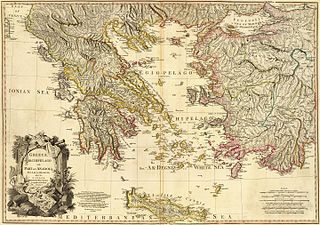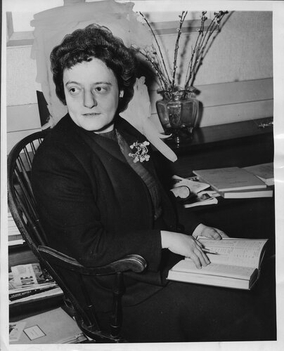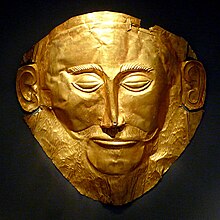
Greek is an independent branch of the Indo-European family of languages, native to Greece, Cyprus, Italy, southern Albania, and other regions of the Balkans, the Black Sea coast, Asia Minor, and the Eastern Mediterranean. It has the longest documented history of any Indo-European language, spanning at least 3,400 years of written records. Its writing system is the Greek alphabet, which has been used for approximately 2,800 years; previously, Greek was recorded in writing systems such as Linear B and the Cypriot syllabary. The alphabet arose from the Phoenician script and was in turn the basis of the Latin, Cyrillic, Coptic, Gothic, and many other writing systems.

Linear A is a writing system that was used by the Minoans of Crete from 1800 to 1450 BC to write the hypothesized Minoan language or languages. Linear A was the primary script used in palace and religious writings of the Minoan civilization. It was succeeded by Linear B, which was used by the Mycenaeans to write an early form of Greek. It was discovered by archaeologist Sir Arthur Evans. No texts in Linear A have yet been deciphered.

Linear B is a syllabic script that was used for writing in Mycenaean Greek, the earliest attested form of the Greek language. The script predates the Greek alphabet by several centuries. The oldest Mycenaean writing dates to about 1400 BC. It is descended from the older Linear A, an undeciphered earlier script used for writing the Minoan language, as is the later Cypriot syllabary, which also recorded Greek. Linear B, found mainly in the palace archives at Knossos, Kydonia, Pylos, Thebes and Mycenae, disappeared with the fall of Mycenaean civilization during the Late Bronze Age collapse. The succeeding period, known as the Greek Dark Ages, provides no evidence of the use of writing.

Michael George Francis Ventris, was an English architect, classicist and philologist who deciphered Linear B, the ancient Mycenaean Greek script. A student of languages, Ventris had pursued decipherment as a personal vocation since his adolescence. After creating a new field of study, Ventris died in a car crash a few weeks before the publication of Documents in Mycenaean Greek, written with John Chadwick.
Philology is the study of language in oral and written historical sources; it is the intersection of textual criticism, literary criticism, history, and linguistics with strong ties to etymology. Philology is also defined as the study of literary texts as well as oral and written records, the establishment of their authenticity and their original form, and the determination of their meaning. A person who pursues this kind of study is known as a philologist. In older usage, especially British, philology is more general, covering comparative and historical linguistics.

Mycenae is an archaeological site near Mykines in Argolis, north-eastern Peloponnese, Greece. It is located about 120 kilometres south-west of Athens; 11 kilometres north of Argos; and 48 kilometres south of Corinth. The site is 19 kilometres inland from the Saronic Gulf and built upon a hill rising 900 feet above sea level.

Mycenaean Greece was the last phase of the Bronze Age in Ancient Greece, spanning the period from approximately 1750 to 1050 BC. It represents the first advanced and distinctively Greek civilization in mainland Greece with its palatial states, urban organization, works of art, and writing system. The Mycenaeans were mainland Greek peoples who were likely stimulated by their contact with insular Minoan Crete and other Mediterranean cultures to develop a more sophisticated sociopolitical culture of their own. The most prominent site was Mycenae, after which the culture of this era is named. Other centers of power that emerged included Pylos, Tiryns, Midea in the Peloponnese, Orchomenos, Thebes, Athens in Central Greece and Iolcos in Thessaly. Mycenaean settlements also appeared in Epirus, Macedonia, on islands in the Aegean Sea, on the south-west coast of Asia Minor, Cyprus, while Mycenaean-influenced settlements appeared in the Levant, and Italy.

The Dorian invasion is a concept devised by historians of Ancient Greece to explain the replacement of pre-classical dialects and traditions in southern Greece by the ones that prevailed in Classical Greece. The latter were named "Dorian" by the ancient Greek writers, after the Dorians, the historical population that spoke them.

Mycenaean Greek is the most ancient attested form of the Greek language, on the Greek mainland and Crete in Mycenaean Greece, before the hypothesised Dorian invasion, often cited as the terminus ad quem for the introduction of the Greek language to Greece. The language is preserved in inscriptions in Linear B, a script first attested on Crete before the 14th century BC. Most inscriptions are on clay tablets found in Knossos, in central Crete, as well as in Pylos, in the southwest of the Peloponnese. Other tablets have been found at Mycenae itself, Tiryns and Thebes and at Chania, in Western Crete. The language is named after Mycenae, one of the major centres of Mycenaean Greece.

John Chadwick, was an English linguist and classical scholar who was most notable for the decipherment, with Michael Ventris, of Linear B.
Greek is an Indo-European language, the sole surviving descendant of the Hellenic sub-family. Although it split off from other Indo-European languages before 2000 BC, it is first attested in the Bronze Age as Mycenaean Greek. During the Archaic and Classical eras, Greek speakers wrote numerous texts in a variety of dialects known collectively as Ancient Greek. In the Hellenistic era, these dialects underwent dialect levelling to form Koine Greek which was used as a lingua franca throughout the eastern Roman Empire, and later grew into Medieval Greek. For much of the period of Modern Greek, the language existed in a situation of diglossia, where speakers would switch between informal varieties known as Dimotiki and a formal one known as Katharevousa. Present-day Modern Standard Greek is largely an outgrowth of Dimotiki, with some features retained from Katharevousa.

Potnia is an Ancient Greek word for "Mistress, Lady" and a title of a goddess. The word was inherited by Classical Greek from Mycenean Greek with the same meaning and it was applied to several goddesses. A similar word is the title Despoina, "the mistress", which was given to the nameless chthonic goddess of the mysteries of Arcadian cult. She was later conflated with Kore (Persephone), "the maiden", the goddess of the Eleusinian Mysteries, in a life-death rebirth cycle which leads the neophyte from death into life and immortality. Karl Kerenyi identifies Kore with the nameless "Mistress of the labyrinth", who probably presided over the palace of Knossos in Minoan Crete.

Alice Elizabeth Kober was an American classicist best known for her work on the decipherment of Linear B. Educated at Hunter College and Columbia University, Kober taught classics at Brooklyn College from 1930 until her death. In the 1940s, she published three major papers on the script, demonstrating evidence of inflection; her discovery allowed for the deduction of phonetic relationships between different signs without assigning them phonetic values, and would be a key step in the eventual decipherment of the script.

Gareth Alun Owens is a British-Greek academic, currently serving as Associate Director and «Erasmus/Socrates» Manager/Tutor of the International Relations Office of the Hellenic Mediterranean University and as Associate Professor of Hellenic Culture -- History, Language and Civilization. He is notable for his contributions to Linear B studies and for his attempts to coordinate the efforts of academics to decipher Linear A.
Leonard Robert Palmer was author and Professor of Comparative Philology at the University of Oxford from 1952 to 1971. He was also a Fellow of Worcester College, Oxford. Palmer made some significant contributions to the study of Classical languages, and in the area of historical linguistics.
In Greek mythology, Perse is one of the 3,000 Oceanids, water-nymph daughters of the Titans Oceanus and Tethys. Her name was also spelled as Persa, Persea or Perseis. Perse married Helios, the god of the sun, and bore him several children, most notably the sorceress-goddess Circe.

Anna Elbina Morpurgo Davies, was an Italian philologist who specialised in comparative Indo-European linguistics. She spent her career at Oxford University, where she was the Professor of Comparative Philology and Fellow of Somerville College.

Lydia Baumbach was a South African classical scholar, known particularly for her work in the field of Mycenaean studies.

PY Ta 641, sometimes known as the Tripod Tablet, is a Mycenaean clay tablet inscribed in Linear B, currently displayed in the National Archaeological Museum, Athens. Discovered in the so-called 'Archives Complex' of the Palace of Nestor at Pylos in Messenia in June 1952 by the American archaeologist Carl Blegen, it has been described as "probably the most famous tablet of Linear B".
















